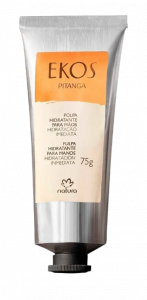Ekos Pitanga Natura Pulpa hidratante para manos

Ingredientes
Aqua
GLYCERIN
CETEARYL ALCOHOL
SORBITOL
SODIUM ACRYLATES COPOLYMER
DICAPRYLYL ETHER
MYRISTYL THEOBROMA GRANDIFLORUM SEEDATE
PHENOXYETHANOL
PARFUM
ASTROCARYUM MURUMURU SEED
BUTTER
PROPYLHEPTYL CAPRYLATE
LECITHIN
DMDM HYDANTOIN
DISODIUM EDTA
BHT
EUGENIA UNIFLORA LEAF OIL
CI 15510
TBHQ
TOCOPHEROL
CI 14700
SODIUM CHLORIDE
HEXYLCINNAMAL
BENZYL SALICYLATE
CITRAL
GERANIOL
CITRONELLOL
Más información
ENVASE: 20% del empaque realizado en material reciclado post-consumo 70% del producto con ingredientes de origen vegetal
El análisis de ingredientes ha sido elaborado por investigadores del CONICET (*) en base a las siguientes referencias bibliográficas:
- Material Safety Data Sheet MSDS# 96129
- Cosmetic Ingredient Review (CIR), Safety Assessment of Polyene Group as Used in Cosmetics Report (2008)
- US - FOOD & DRUG Administration (FDA). Generally Recognized as Safe (GRAS) Substances (SCOGS) Database (SCOGS Number 9,1972. Conclusion 1)
- CIR (Cosmetic Ingredient Review). Safety Assessment of Acrylates Copolymers as Used in Cosmetics (2018).
- Rillig, M. C., et al. (2019). Microplastic effects on plants. New Phytologist, 223(3), 1066-1070.
- Sussarellu, R., et al. (2016). Oyster reproduction is affected by exposure to polystyrene microplastics. Proceedings of the National Academy of Sciences, 113(9), 2430-2435.
- Fiume, Monice M., Bart A. Heldreth, Wilma F. Bergfeld, Donald V. Belsito, Ronald A. Hill, Curtis D. Klaassen, Daniel C. Liebler et al. Safety assessment of alkyl esters as used in cosmetics. International journal of toxicology 34, no. 2_suppl (2015): 5S-69S.
- Material Safety Data Sheet MSDS# 96171
- Chasset, F., Soria, A., Moguelet, P., Mathian, A., Auger, Y., François, C., and Barete, S. (2015). Contact dermatitis due to ultrasound gel: A case report and published work review. The Journal of dermatology.
- Bohn, S., and Bircher, A. J. (2001). Phenoxyethanol induced urticaria. Allergy, 56(9), 922-923.
- SCCNFP (The Scientific Committee on Cosmetic Products and Non-Food Products Intended for Consumers) 1999. Opinion concerning fragrance allergy in consumers. A review of the problem. Analysis of the need for appropriate consumer information and identification of consumer allergens. SCCNFP/0017/98 Final. December 199 - Tatyana Hamilton and Gillian C de Gannes. 2011. Allergic contact dermatitis to preservatives and fragrances in cosmetics. Skin therapy letter 16(4), 1-4 .- Anne Birgitte Simonsen, Mette Deleuran, Jeanne Duus Johansen and Mette Sommerlund 2011. Contact allergy and allergic contact dermatitis in children - a review of current data. Contact dermatitis 65(5), 254-65.
- European Commission Legislation (Regulation (EC) N° 1223/2009 y 2019/831, Annexes I to VI and all the amendments to the cosmetics regulation).
- US - FOOD & DRUG Administration (FDA). Generally Recognized as Safe (GRAS) Substances (SCOGS) Database (SCOGS Number 106,1979. Conclusion 1)
- Liebert, M. A. (1988). Final report on the safety assessment of DMDM hydantoin. Journal of American collage of toxicology, 7(3).
- Lanigan RS, Yamarik TA. Int J Toxicol. 2002, 21 Suppl 2:95‐142.
- Orenstein, A., Kostenich, G., Tsur, H., Roitman, L., Ehrenberg, B., & Malik, Z. (1995) in Photodynamic therapy of cancer II (Vol. 2325, pp. 100-105). International Society for Optics and Photonics.
- L. Gue, What's Inside? That Counts. A Survey of Toxic Ingredients in our Cosmetics (2010), Pg. 10 and 11.
- European Food Safety Authority 2012. EFSA. 2012. Panel on Food Additives and Nutrient Sources added to Food (ANS)
- Scientific Opinion on the re-evaluation of Butylated hydroxytoluene BHT (E 321) as a food additive. EFSA Journal 10(3), 2588.
- European Chemicals Agency (ECHA) 2018. GHS Data from ECHA Website. Appears as: chemical_names: Sodium 4-[(2-hydroxy-1-naphthyl)azo]benzenesulphonate
- sodium 4-[(E)-2-(2-hydroxynaphthalen-1-yl)diazen-1-yl]benzene-1-sulfonate
- Acid Orange 7
- Sodium 4-[(2-hydroxy-1-naphthyl)azo]benzenesulphonate
- sodium 4-[(2-hydroxy-1-naphthyl)diazenyl]benzene
- cas_numbers: 633-96-5
- European Commission, Scientific Committee on Consumer Safety (SCCS) 2014. Opinion on Acid Orange7 COLIPA n° C15.
- National Toxicology Program (NTP) 2015. EWG Toxcast Analysis. Appears as: CAS: 633-96-5
- Chemical_Name: Acid Orange II
- European Chemical Agency (ECHA).
- US - FOOD & DRUG Administration (FDA). Generally Recognized as Safe (GRAS) Substances (SCOGS) Database (SCOGS Number 102,1979. Conclusion 1 (dry food packaging), 4 (direct additive)
- European Commission. 2013. Cosing, the European Commission database with information on cosmetic substances and ingredients. Accessed on March 1, 2013 at http://ec.europa.eu/consumers/cosmetics/cosing/ .
- EU GHS Hazard Labeling Codes 2012. GHS Hazard Codes. Appears as: Chemical Name: citral
- CAS number: 5392-40-5
- Classification Hazard Statement Codes: H315|H317
- SCCPNFP, 1999 Opinion Concerning Fragrance Allergy In Consumers, Scientific Committee On Cosmetic Products And Non-Food Products. SCCNFP/0017/98 Final, December 1999.
(*) Según el ranking SCImago 2020, el CONICET alcanza la segunda posición entre las instituciones académicas y de investigación más prestigiosas de América Latina. A nivel mundial, ocupa la posición 230 entre 7000 instituciones privadas y gubernamentales.

